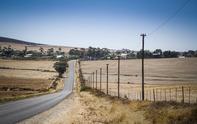Tortoise Location

On a private conservancy outside of Cape Town, South Africa, Dr Brian Henen studied the last few remaining generations of the endangered geometric tortoise. For enigmatic reasons of its own, the geometric tortoise seems to live only in renosterveld, that dull-looking, scrubby vegetation that forms a strange no-man's land between the succulent Karoo and fynbos in the western parts of the country.
The tortoise has not been found in any other plant communities and even seems to be fussy about certain types of renosterveld. Because its habitat has been carved up and sterilised by monoculture, communities of geometrics have retreated to the hills. As the vegetation is shaved away slowly by the plough shear, patches of renosterveld have become smaller and smaller, and so have the communities of tortoises living there.
Fragmented populations are scattered across the region from Wellington to the Ceres Valley. They are estimated to have a population density of about one or two tortoises per hectare, so a ten hectare patch of renosterveld may only have ten tortoises. Count the few remaining mounds of renosterveld next time you are travelling through the wheat fields of the Swartland and the Overberg, and then do the maths.
Genetic Cul-de-sac
Dr Henen reckons there are not more than three or four populations of geometrics remaining that are large enough to be genetically viable. A viable population is one that can persist for a long period of time - not a year, or five years, but a few thousand years. A population like this may experience fluctuations over the years but will essentially be stable over time.
Such minute hilltop communities are living museums of species existing in a genetic cul-de-sac. Before long, in-breeding will weaken some and pare down their numbers. It will be more and more difficult to recover from any natural dips in their abundance through drought or fire or flood. Ultimately, it's only a matter of time.
Alarmingly, some developers have been known to use this excuse to motivate a new development. Why bother saving a species, they argue, when it's going to be extinct in twenty years from now? It's a bit like pulling the plug on a coma patient when you are not sure whether he or she is past the point of no return.
A Geometric's Life Story
The life story of a geometric tortoise is one only recently unveiled. When a hatchling ventures from its shell, it is a bantamweight - weighing in at only 15 grams (a medium-sized chicken egg weighs about 50 grams, according to my kitchen scale).
For the following two to three years of life - when a human child would be learning to walk and mastering the rudiments of language - it will battle the odds with a shell no more rigid than a weak fingernail. It will use its markings as camouflage, while it waits out the time until its body can scavenge enough calcium from the environment to harden its shell, which is an externalised extension to its ribcage.
The early years of the geometric tortoise are precarious and only a few animals make it through their youth. By the time the human child would be settled into Grade 4, or even witnessing the distant approach of adolescence, the geometric tortoise might just be classified as an adult, aged eight to ten years.
It will have another forty years (perhaps a few more) before it needs to consider retirement. It's vital to piece together these tortoises' lives and how they slot into the overall system. If anything changes, scientists need to know what has changed, and by how much.
With the geometric tortoise, it's too late to get authentic baseline information because the animal's habitat and numbers have shrunk so dramatically that all science can do is record its current status, precipitously close to being gone forever.